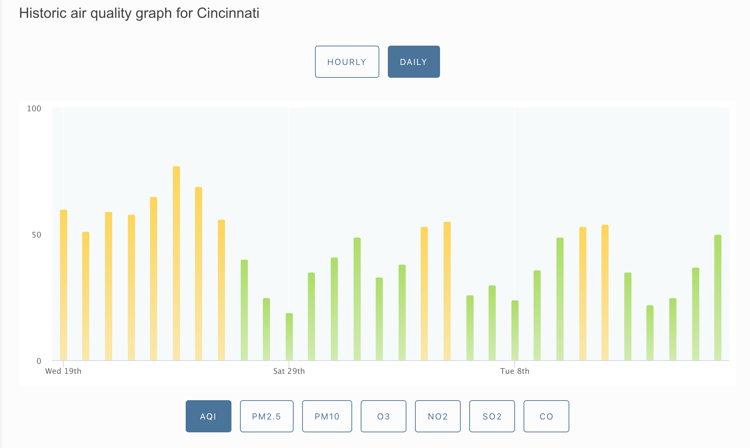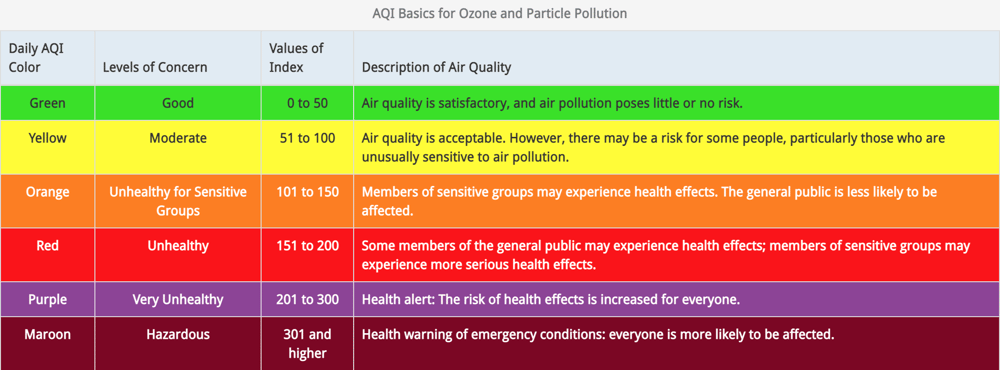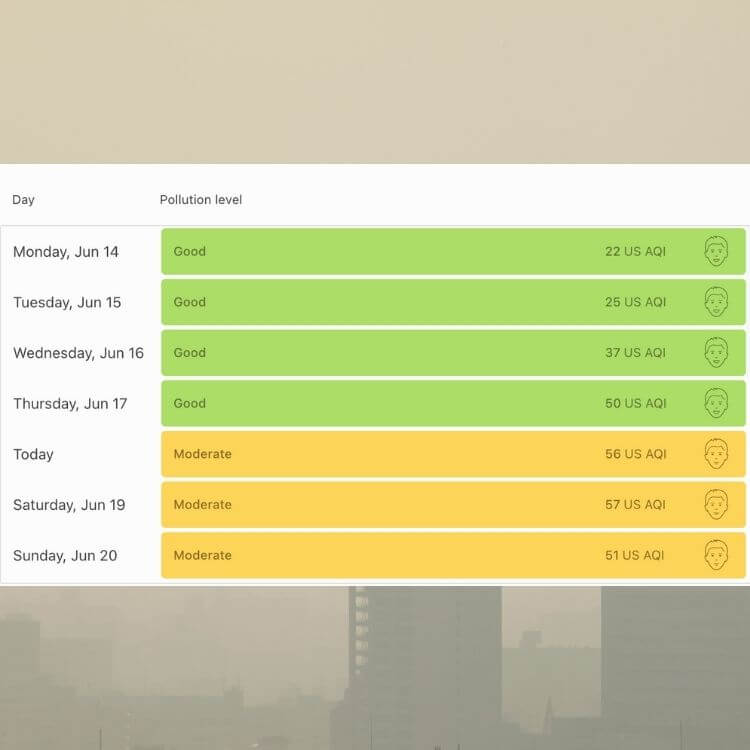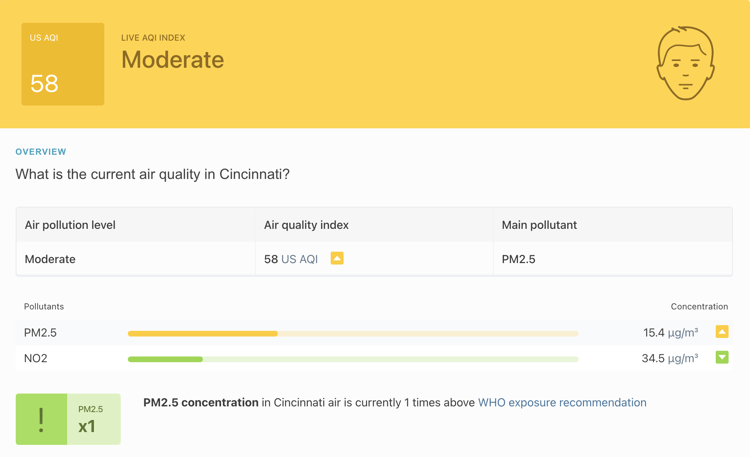If you have recently checked the weather on an app or online, you may have noticed a colorful scale rating the air quality. That’s the air quality index, and it’s an important tool that is used to avoid unhealthy air pollutants.
Whenever you plan an outdoor activity like a picnic or trip to the zoo, you’re probably in the habit of checking the forecast for rain. But there’s more that you should watch for than just precipitation. Looking at the Air Quality Index in Cincinnati, or wherever you may be, is an important habit to have whenever you’re planning for something outside.
Source: https://www.iqair.com/us/usa/ohio/cincinnati
What is the Air Quality Index?
In order to rate the quality of the outdoor air in an area, government agencies use air quality measurements. Different countries have slightly different ranking systems and with different names. In the United States, it’s the Air Quality Index, developed by the United States Environmental Protection Agency.

Source: https://www.iqair.com/us/usa/ohio/cincinnati
The Air Quality Index rates the outdoor air quality in six categories ranging from “Good” to “Hazardous.” Each rating has a title that will tell you whether you should avoid the outdoor air depending on how sensitive you are.
The AQI ratings are calculated using a complicated equation that looks at the pollutant concentration. Fortunately, the system that the EPA designed for communicating the AQI is much simpler to understand. Once you learn the basics, you’ll soon have the hang of checking in on the day’s AQI rating.
What makes an area at risk of high air pollution?
Air quality is affected by a number of pollutants, and certain areas are far more likely than others to have low air quality. For instance, if you are hiking in the mountains or spending time out in the country, the air quality is probably fine. But, if you’re visiting Los Angeles or living in a crowded area like Cincinnati you should be cautious.
Big cities like New York, San Francisco, and even Cincinnati tend to have poorer ratings on the AQI scale. Pollution like emissions from cars or power plants significantly increase the amount of carbon monoxide or particular matter that is in the air.
Weather can also be a factor in the quality of outdoor air. Wind and rain can sometimes help clear the air of pollutants, but not always. Sometimes precipitation dissolves sulfur dioxide and leads to acid rain.
Areas that are prone to wildfires need to be particularly aware of the Air Quality Index. Wildfires create smoke with dangerous pollutants, like carbon monoxide and nitrogen dioxide.
When and why should I check the Air Quality Index?
Even though Cincinnati doesn’t have to worry about wildfires or quite as much traffic as bigger cities, air quality still plays a role in planning for a healthy life. With the AQI forecast on most smartphone apps and online weather reports, it’s worthwhile to take a look at the current rating every day. In doing so, you’ll get used to reading it and taking the air quality into consideration over the long run.
Sensitive groups need to pay even more attention to the AQI. Children, elderly people, and people with lung diseases like asthma are at a higher risk of experiencing health problems from air pollution. In order to protect themselves from bad air quality, sensitive groups should stay indoors whenever possible when the AQI forecasts a rating of 101 or higher.
If you’re not someone with a lung disease or other risk factors, it may seem like checking the air quality in your city is unnecessary. However, the numbers suggest that poor air quality is a serious and dangerous condition. For instance, thousands of people are checked into the ER every year in New York for exposure to particulate matter. Several hundred people die prematurely each year from exposure to ozone, which can cause permanent damage to the lungs.
Ultimately, it’s a good idea for everyone to check the AQI regularly. The simple forecast is a priceless gift that can help you avoid unnecessary health problems.
Source: https://www.iqair.com/us/usa/ohio/cincinnati
How do I read the Air Quality Index in Cincinnati
The AQI is organized by numbers and colors. The numbers rank the quality of the air and run from zero to 500. Six different colors correspond to the numbers to further indicate the severity of the rating.
For instance, AQI values of 50 or lower are within the green category, which is considered “Good,” or the lowest possible health concern. Above green, there’s the yellow category, which runs from 51 to 100. Pollution levels within this range pose a moderate health concern. The next range, 101 to 150 is orange, and labeled “Unhealthy for Sensitive Groups, followed by red for 151 to 200 labeled “Unhealthy” in general. The top 300 numbers, 201 to 500, are in the purple and maroon categories, labeled “Very Unhealthy” and “Hazardous” respectively.

Source: https://www.airnow.gov/aqi/aqi-basics/
The EPA designed the AQI to be as intuitive as possible. When you look at the Air Quality Index for an area, you can see by the colors and the labels just how concerned you should be. For instance, if you have bad asthma and you see that the air quality is orange, you’ll know that you should stay inside to avoid any risk to your health from the day’s pollution.
There are numerous ways to find the AQI value for Cincinnati on any given day. Depending on what weather app you use on your phone, you may be able to see the ranking there. You can also visit a website like accuweather.com to get a fuller report. This can be helpful for planning ahead, since it actually gives you a predicted forecast for the AQI value in the coming days.
In a full report such as on accuweather.com, you’ll also see a breakdown of the five major pollutants that the EPA takes into consideration for the AQI. These are ground-level ozone, particle pollution, carbon monoxide, sulfur dioxide, and nitrogen dioxide.
By looking through an AQI forecast, you can learn which individuals should be cautious of the upcoming air quality, and make safe decisions for outdoor experiences.
Worried about the pollution outside getting inside your home? Talk to the Air Quality Experts at The Geiler Company.



